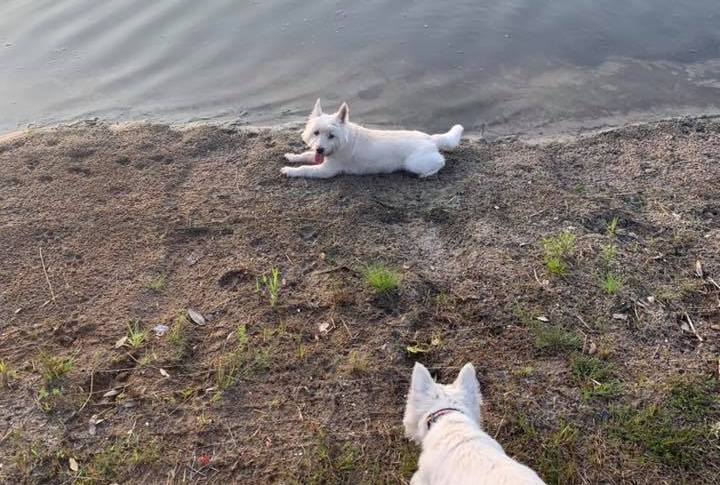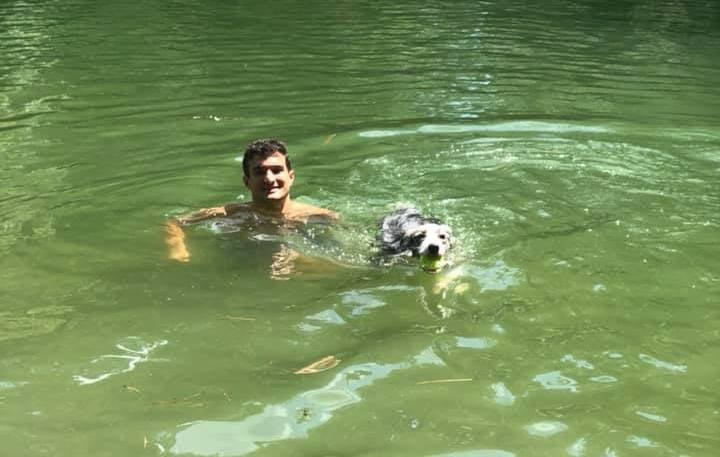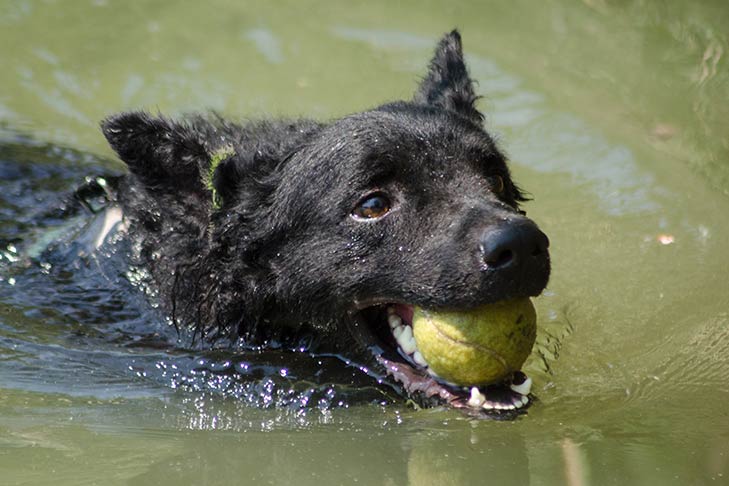- Blue-green algae are toxic and deadly when consumed in high concentrations
- Dogs are more vulnerable to blue-green algae poisoning because of their likelihood to play
- This bacteria is often found in non-flowing freshwater during hot seasons
In the summer of 2019, the news shocked dog owners across social media: three dogs died after playing in a pond in Wilmington, North Carolina, while another died after a swim in Lake Allatoona, Georgia, and three different dogs died after playing in a lake in Austin. What led to the deaths of all seven dogs? Likely, liver failure was brought on by ingesting water contaminated with toxic blue-green algae.
This summer, blue-green algae are back. While many dog owners are getting outdoors, there are safety precautions to be aware of before allowing your dog to swim.
What’s Going on With Dogs and Blue-Green Algae?
On August 9, 2019, Melissa Martin of Wilmington, North Carolina shared the passing of all three of her dogs:

“At 12:08 AM, our dogs crossed the rainbow bridge together. They contracted blue-green algae poisoning and there was nothing they could do. We are gutted. I wish I could do today over…”

The following day, Morgan Fleming of Marietta Georgia posted:
“This morning we thought, it’s so hot! Let’s go to the lake! We took our sweet Arya to the lake and had the best day playing ball and swimming around! About 30 minutes later on the drive home, we noticed her making weird noises and she threw up and pooped in the car. We called our vet on the drive and they suggested we take her in. By this point, our girl couldn’t even stand…”

Both posts were shared thousands of times on social media.
A local veterinarian’s office in Wilmington sent out an email warning pet owners that dogs who ingest algae often face death.
“Please be aware of the current bloom of blue-green algae in our area. Blooms of blue-green algae can be toxic to canines and most often fatal. If you feel your pet has been in contact with blue-green algae please rinse with freshwater and seek veterinary help immediately,” the email reads.
That said, the so-called “algae” is not actually a type of algae but a bacteria known as cyanobacteria. Cyanobacteria isn’t visible to the naked eye, but it often gives the appearance of algae when it clumps together in bodies of water. This bacteria is often found in non-flowing freshwater during hot seasons with little rainfall. Toxic algae can also grow in backyard pools and decorative ponds if they aren’t routinely cleaned.
How Do Dogs Ingest Blue-Green Algae?
Dogs more than other animals are vulnerable to ingesting the toxic algae because of their tendency to play in the water. If your dog is a fetcher and catches tennis balls or other round-shaped toys, this can lead to greater water ingestion and even water intoxication. Dogs may also lick the toxic bacteria off their fur or paws.
Can Humans Be Harmed by Blue-Green Algae?
When high concentrations of these cyanobacteria toxins are consumed, they can poison not only domestic animals like dogs but humans as well.
What Causes Blue-Green Algae?
- Nutrients such as phosphorus and nitrogen
- Stable, slow-moving, or stagnant water
- Hot temperatures
- Intermittent exposure to high light intensity

Tips to Avoid Blue-Green Algae Poisoning:
- Keep your dog leashed around bodies of water, especially if the water appears dirty, foamy, or has mats on the surface of the water.
- Don’t let your dog drink out of ponds and lakes
- Harmful algae blooms, which can be blue, vibrant green, brown or red, are sometimes mistaken for paint floating on the water. Be aware the toxins aren’t always visible.
- Toxic algae often stink, sometimes producing a downright nauseating smell, yet animals may be attracted to the smell and taste of them, according to the EPA.
- Local government may treat bodies of water known to have blue-green algae to protect both humans and animals.
What Do I Do if I Know my Dog Has Been Exposed to Blue-Green Algae?
Rinse your dog off immediately with clean water if they come in contact with blue-green algae. Call your veterinarian immediately.
Signs/Symptoms Your Dog May Have Ingested Blue-Green Algae:
Symptoms, which usually arise anywhere from 15 minutes to several days after exposure may include:
- Diarrhea or vomiting
- Drooling
- Neurologic signs such as:
- Weakness
- Disorientation/confusion
- Collapse/unconsciousness
- Seizures
- Breathing difficulties
If any of these signs occur, contact your vet immediately. If caught early enough, your vet may be able to flush out the toxins before your dog becomes completely affected.


